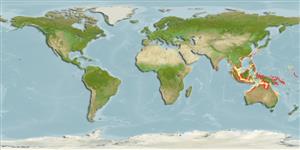Environment: milieu / climate zone / depth range / distribution range
Écologie
marin; saumâtre démersal. Tropical
Indo-West Pacific: South and southeast Asia, southern New Guinea and northern Australia.
Taille / Poids / Âge
Maturity: Lm ? range ? - ? cm
Max length : 50.0 cm TL mâle / non sexé; (Ref. 58022)
Épines dorsales (Total): 1; Épines anales 0; Rayons mous anaux: 14 - 21. Head depressed and elongate, 27 - 36% (mean 32%) of SL; exposed shield very striate or sharply granular. Narrow supraoccipital process, always keeled. Low set eyes. Small mouth, width 24 - 40% (mean 31%) of HL. Gill rakers absent on hind aspect of first 2 gill arches. Posterior epithelial ridges of palate run transversely. Caudal peduncle depth, 1.3 - 2.1 in its length (Ref. 38478).
Occurs in inshore waters over soft bottoms (Ref. 7300). Feeds on detritus, prawns, soft-bodied organisms, and mud (Ref. 38478).
Life cycle and mating behavior
Maturité | Reproduction | Frai | Œufs | Fécondité | Larves
Marceniuk, A.P. and N.A. Menezes, 2007. Systematics of the family Ariidae (Ostariophysi, Siluriformes), with a redefinition of the genera. Zootaxa 1416:1-126. (Ref. 58022)
Statut dans la liste rouge de l'IUCN (Ref. 130435)
Menace pour l'homme
Traumatogenic (Ref. 58010)
Utilisations par l'homme
Plus d'informations
Noms communsSynonymesMétabolismePrédateursÉcotoxicologieReproductionMaturitéFraiRassemblement de ponteFéconditéŒufsDéveloppement de l'œuf
RéférencesAquacultureProfil d'aquacultureSouchesGénétiqueElectrophoresesHéritabilitéPathologiesTraitementNutrientsMass conversion
CollaborateursImagesStamps, Coins Misc.SonsCiguateraVitesseType de nageSurface branchialeOtolithesCerveauxVision
Outils
Articles particuliers
Télécharger en XML
Sources Internet
Estimates based on models
Preferred temperature (Ref.
123201): 25.6 - 29.1, mean 28.3 °C (based on 1122 cells).
Phylogenetic diversity index (Ref.
82804): PD
50 = 0.5039 [Uniqueness, from 0.5 = low to 2.0 = high].
Bayesian length-weight: a=0.00525 (0.00269 - 0.01023), b=3.11 (2.94 - 3.28), in cm total length, based on LWR estimates for this (Sub)family-body shape (Ref.
93245).
Niveau trophique (Ref.
69278): 3.8 ±0.2 se; based on diet studies.
Résilience (Ref.
120179): Milieu, temps minimum de doublement de population : 1,4 à 4,4 années (Preliminary K or Fecundity.).
Fishing Vulnerability (Ref.
59153): Moderate vulnerability (40 of 100).
